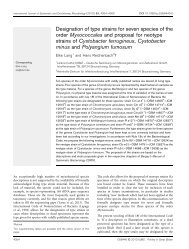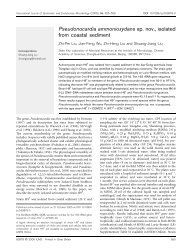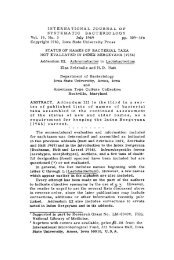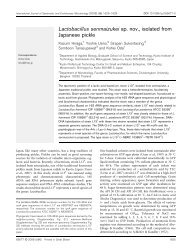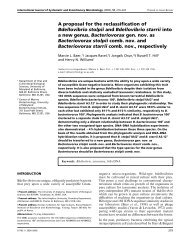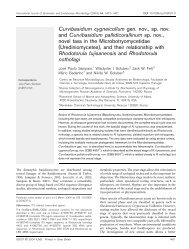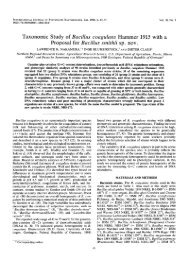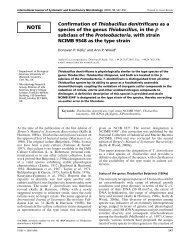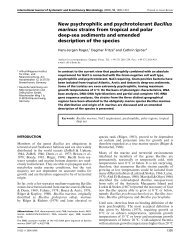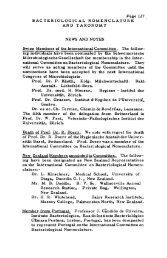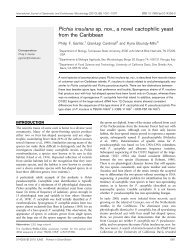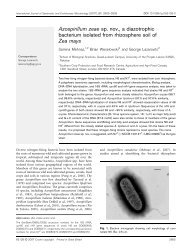Transfer of Streptococcus faecalis and Streptococcus faecium to the ...
Transfer of Streptococcus faecalis and Streptococcus faecium to the ...
Transfer of Streptococcus faecalis and Streptococcus faecium to the ...
You also want an ePaper? Increase the reach of your titles
YUMPU automatically turns print PDFs into web optimized ePapers that Google loves.
INTERNATIONAL JOURNAL OF SYSTEMATIC BACTERIOLOGY, Jan. 1984, p. 31-34<br />
OO20-7713/84/01003 1-04$02.00/0<br />
Copyright 0 1984, International Union <strong>of</strong> Microbiological Societies<br />
Vol. 34, No. 1<br />
<strong>Transfer</strong> <strong>of</strong> <strong>Strep<strong>to</strong>coccus</strong> <strong>faecalis</strong> <strong>and</strong> <strong>Strep<strong>to</strong>coccus</strong> <strong>faecium</strong> <strong>to</strong> <strong>the</strong><br />
Genus Enterococcus norn. rev. as Enterococcus <strong>faecalis</strong> comb. nov.<br />
<strong>and</strong> Enterococcus <strong>faecium</strong> comb. nov.<br />
KARL H. SCHLEIFER* AND RENATE KILPPER-BALZ<br />
Lehrstuhl fur Mikrobiologie, Technische Universitat Miinchen, D-8000 Miinchen 2, Federal Republic <strong>of</strong> Germany<br />
The results <strong>of</strong> deoxyribonucleic acid-deoxyribonucleic acid <strong>and</strong> deoxyribonucleic acid-ribosomal ribonu-<br />
cleic acid hybridization studies demonstrated that <strong>Strep<strong>to</strong>coccus</strong> <strong>faecalis</strong> <strong>and</strong> <strong>Strep<strong>to</strong>coccus</strong> <strong>faecium</strong> are<br />
distantly related <strong>to</strong> <strong>the</strong> non-enterococcal strep<strong>to</strong>cocci (<strong>Strep<strong>to</strong>coccus</strong> hovis <strong>and</strong> <strong>Strep<strong>to</strong>coccus</strong> equinus) <strong>of</strong><br />
serological group D <strong>and</strong> <strong>to</strong> o<strong>the</strong>r strep<strong>to</strong>cocci. On <strong>the</strong> basis <strong>of</strong> our results <strong>and</strong> those <strong>of</strong> previous studies, we<br />
propose that S. <strong>faecalis</strong> <strong>and</strong> S. <strong>faecium</strong> be transferred <strong>to</strong> <strong>the</strong> genus Enterococcus (ex Thiercelin <strong>and</strong><br />
Jouhaud) nom. rev. as Enterococcus <strong>faecalis</strong> (Andrewes <strong>and</strong> Horder) comb. nov. <strong>and</strong> Enterococcus<br />
<strong>faecium</strong> (Orla-Jensen) comb. nov., respectively. A description <strong>of</strong> <strong>the</strong> genus Enterococcus nom. rev. <strong>and</strong><br />
emended descriptions <strong>of</strong> E. <strong>faecalis</strong> <strong>and</strong> E. <strong>faecium</strong> are given.<br />
The strep<strong>to</strong>cocci belonging <strong>to</strong> serological group D can be<br />
divided in<strong>to</strong> two physiologically different groups. Strep<strong>to</strong>-<br />
coccus <strong>faecalis</strong> <strong>and</strong> <strong>Strep<strong>to</strong>coccus</strong> <strong>faecium</strong> were placed in<br />
<strong>the</strong> enterococcus division <strong>of</strong> <strong>the</strong> strep<strong>to</strong>cocci, whereas<br />
<strong>Strep<strong>to</strong>coccus</strong> bovis <strong>and</strong> <strong>Strep<strong>to</strong>coccus</strong> equinus were placed<br />
in <strong>the</strong> viridans division by Sherman (21). Kalina proposed (9)<br />
that <strong>Strep<strong>to</strong>coccus</strong> <strong>faecalis</strong> <strong>and</strong> <strong>Strep<strong>to</strong>coccus</strong> <strong>faecium</strong><br />
should be transferred <strong>to</strong> <strong>the</strong> genus “Enterococcus.” This<br />
distinction between <strong>the</strong> enterococci <strong>and</strong> <strong>Strep<strong>to</strong>coccus</strong> bo-<br />
vis, <strong>Strep<strong>to</strong>coccus</strong> equinus, <strong>and</strong> o<strong>the</strong>r strep<strong>to</strong>cocci has also<br />
been demonstrated by comparative biochemical (25) <strong>and</strong><br />
immunological (14, 15) studies. More recently, nucleic acid<br />
studies (7, 12) have confirmed that <strong>Strep<strong>to</strong>coccus</strong> <strong>faecalis</strong><br />
<strong>and</strong> <strong>Strep<strong>to</strong>coccus</strong> <strong>faecium</strong> are only distantly related <strong>to</strong><br />
<strong>Strep<strong>to</strong>coccus</strong> bovis <strong>and</strong> <strong>Strep<strong>to</strong>coccus</strong> equinus. In particu-<br />
lar, deoxyribonucleic acid (DNA)-ribosomal ribonucleic acid<br />
(rRNA) homology studies (12) <strong>and</strong> comparative oligonucleo-<br />
tide cataloging <strong>of</strong> 16s rRNA (E. Seewaldt, Ph.D. <strong>the</strong>sis,<br />
Technische Universitat Munchen, Munich, Federal Repub-<br />
lic <strong>of</strong> Germany, 1982) have indicated that <strong>the</strong> enterococcal<br />
<strong>and</strong> non-enterococcal group D strep<strong>to</strong>cocci belong <strong>to</strong> differ-<br />
ent genera. In this paper we extend <strong>the</strong>se studies, <strong>and</strong> on <strong>the</strong><br />
basis <strong>of</strong> <strong>the</strong> data we propose that <strong>Strep<strong>to</strong>coccus</strong> <strong>faecalis</strong> <strong>and</strong><br />
<strong>Strep<strong>to</strong>coccus</strong> <strong>faecium</strong> be transferred <strong>to</strong> <strong>the</strong> genus Entero-<br />
coccus (ex Thiercelin <strong>and</strong> Jouhaud) nom. rev. (22).<br />
MATERIALS AND METHODS<br />
The test strains which we used are listed in Table 1. The<br />
strep<strong>to</strong>cocci were cultivated in CASO-bouillon medium (E.<br />
Merck AG, Darmstadt, Germany) without aeration at 34°C.<br />
Staphylococcus sciuri <strong>and</strong> Escherichia coli were grown in<br />
shake flasks containing glucose-pep<strong>to</strong>ne-yeast extract broth<br />
(13) at 34°C. All strains were harvested in <strong>the</strong> exponential<br />
phase. The procedures used <strong>to</strong> prepare cell walls <strong>and</strong> deter-<br />
mine <strong>the</strong> peptidoglycan types have been described previous-<br />
ly (19, 20). Isolation <strong>of</strong> DNA <strong>and</strong> rRNA <strong>and</strong> nucleic acid<br />
hybridization experiments were carried out as described<br />
previously (11-13). The stability <strong>of</strong> DNA-rRNA hybrids is<br />
expressed by <strong>the</strong>ir melting temperatures. DNA base compo-<br />
sitions were determined by <strong>the</strong>rmal denaturation (16), using<br />
a Gilford model 2600 spectropho<strong>to</strong>meter. DNA from Esche-<br />
richia coli K-12 was used as <strong>the</strong> st<strong>and</strong>ard. The guanine-plus-<br />
cy<strong>to</strong>sine (G+C) contents were calculated by <strong>the</strong> method <strong>of</strong><br />
* Corresponding author.<br />
31<br />
De Ley (4) <strong>and</strong> were corrected <strong>to</strong> <strong>the</strong> value for <strong>the</strong> reference<br />
Escherichia coli K-12 DNA.<br />
RESULTS AND DISCUSSION<br />
The DNA base compositions, serological groups, <strong>and</strong><br />
peptidoglycan types <strong>of</strong> <strong>the</strong> test strains are shown in Table 1.<br />
The enterococci studied (<strong>Strep<strong>to</strong>coccus</strong> <strong>faecalis</strong>, <strong>Strep<strong>to</strong>coccus</strong><br />
<strong>faecium</strong>, “<strong>Strep<strong>to</strong>coccus</strong> avium” , “<strong>Strep<strong>to</strong>coccus</strong><br />
durans”, <strong>and</strong> “<strong>Strep<strong>to</strong>coccus</strong> casselifiavus”) had DNA<br />
G+C contents in <strong>the</strong> range from 37 <strong>to</strong> 43 mol%. These data<br />
are in good agreement with <strong>the</strong> data given recently by<br />
Farrow et al. (7); however, <strong>the</strong>y are about 1 <strong>to</strong> 2 mol% lower<br />
than <strong>the</strong> values reported by Kilpper-Balz et al. (12), who<br />
used a value for <strong>the</strong> base composition <strong>of</strong> <strong>the</strong> reference DNA<br />
that was <strong>to</strong>o high (53 instead <strong>of</strong> 51.7 mol%).<br />
<strong>Strep<strong>to</strong>coccus</strong> <strong>faecalis</strong> <strong>and</strong> its subspecies possess <strong>the</strong> Lys-<br />
Alaz-3 peptidoglycan type <strong>and</strong> differ in this respect from all <strong>of</strong><br />
<strong>the</strong> o<strong>the</strong>r enterococci, which contain <strong>the</strong> LYS-D-ASP peptidoglycan<br />
type (8, 12, 20). The results <strong>of</strong> previous studies, in<br />
particular those <strong>of</strong> Kilpper-Balz et al. (12) <strong>and</strong> Seewaldt<br />
(Ph.D. <strong>the</strong>sis), clearly indicated that <strong>the</strong> enterococci are not<br />
closely related <strong>to</strong> <strong>the</strong> o<strong>the</strong>r strep<strong>to</strong>cocci. In this study 3Hlabeled<br />
23s rRNAs from <strong>Strep<strong>to</strong>coccus</strong> <strong>faecalis</strong> DSM 20376<br />
<strong>and</strong> “<strong>Strep<strong>to</strong>coccus</strong> avium” DSM 20063 were hybridized<br />
with filter-bound DNAs from strains <strong>of</strong> <strong>Strep<strong>to</strong>coccus</strong> <strong>faecalis</strong>,<br />
<strong>Strep<strong>to</strong>coccus</strong> <strong>faecium</strong>, “<strong>Strep<strong>to</strong>coccus</strong> durans”,<br />
“<strong>Strep<strong>to</strong>coccus</strong> casselifiavus”, <strong>and</strong> some o<strong>the</strong>r strep<strong>to</strong>cocci<br />
(Table 2). Our results indicate that all <strong>of</strong> <strong>the</strong> enterococci<br />
examined share high rRNA homology <strong>and</strong> are only remotely<br />
related <strong>to</strong> o<strong>the</strong>r strep<strong>to</strong>cocci (Table 2).<br />
The results <strong>of</strong> our DNA-DNA hybridization studies (Fig.<br />
1) confirm <strong>the</strong> separate species status <strong>of</strong> <strong>Strep<strong>to</strong>coccus</strong><br />
<strong>faecalis</strong> <strong>and</strong> <strong>Strep<strong>to</strong>coccus</strong> <strong>faecium</strong> (7, 12). All strains <strong>of</strong><br />
<strong>Strep<strong>to</strong>coccus</strong> <strong>faecalis</strong> were closely related (DNA homology<br />
values, 88%) regardless <strong>of</strong> <strong>the</strong>ir subspecies status. The<br />
<strong>Strep<strong>to</strong>coccus</strong> <strong>faecium</strong> strains showed low but still significant<br />
levels <strong>of</strong> DNA homology (ca. 18%) with <strong>Strep<strong>to</strong>coccus</strong><br />
<strong>faecalis</strong>. The very low levels <strong>of</strong> DNA homology (
32 SCHLEIFER AND KILPPER-BALZ INT. J. SYST. BACTERIOL.<br />
TABLE 1. Bacterial strains used <strong>and</strong> <strong>the</strong>ir serological groups,<br />
DNA base contents, <strong>and</strong> peptidoglycan types<br />
Strain<br />
“<strong>Strep<strong>to</strong>coccus</strong> avium” DSM 20063<br />
“<strong>Strep<strong>to</strong>coccus</strong> bovis” DSM 20480Ta<br />
“<strong>Strep<strong>to</strong>coccus</strong> casseliflavus”<br />
CCM 2478<br />
“<strong>Strep<strong>to</strong>coccus</strong> casselijlavus’ ’<br />
CCM 2479<br />
“<strong>Strep<strong>to</strong>coccus</strong> durans” CCM 5612<br />
“<strong>Strep<strong>to</strong>coccus</strong> durans” Kiel 27382<br />
“<strong>Strep<strong>to</strong>coccus</strong> <strong>faecalis</strong>” DSM<br />
20478T<br />
“<strong>Strep<strong>to</strong>coccus</strong> <strong>faecalis</strong> subsp. <strong>faecalis</strong>”<br />
DSM 20376<br />
“<strong>Strep<strong>to</strong>coccus</strong> <strong>faecalis</strong> subsp. <strong>faecalis</strong>”<br />
Kiel 7067<br />
“<strong>Strep<strong>to</strong>coccus</strong> <strong>faecalis</strong> subsp. liquefaciens”<br />
Kiel 26506<br />
“<strong>Strep<strong>to</strong>coccus</strong> <strong>faecalis</strong> subsp. zymogenes’<br />
’ Kiel 20225<br />
<strong>Strep<strong>to</strong>coccus</strong> <strong>faecium</strong> DSM 20477T<br />
<strong>Strep<strong>to</strong>coccus</strong> <strong>faecium</strong> DSM 20160<br />
<strong>Strep<strong>to</strong>coccus</strong> <strong>faecium</strong> CCM 2123<br />
<strong>Strep<strong>to</strong>coccus</strong> <strong>faecium</strong> CCM 2308<br />
<strong>Strep<strong>to</strong>coccus</strong> <strong>faecium</strong> CCM 2423<br />
<strong>Strep<strong>to</strong>coccus</strong> <strong>faecium</strong> CCM 2424<br />
<strong>Strep<strong>to</strong>coccus</strong> <strong>faecium</strong> Kiel 26352<br />
<strong>Strep<strong>to</strong>coccus</strong> lactis DSM 20481T<br />
<strong>Strep<strong>to</strong>coccus</strong> mutans ATCC 25175T<br />
<strong>Strep<strong>to</strong>coccus</strong> species Kiel 9938’<br />
<strong>Strep<strong>to</strong>coccus</strong> <strong>the</strong>rmophilus DSM<br />
20479<br />
Staphylococcus sciuri ATCC 29062=<br />
Escherichia coli DSM 30083<br />
D<br />
D<br />
D<br />
D<br />
D<br />
D<br />
D<br />
N<br />
Q<br />
39.0<br />
37.4<br />
38.6<br />
38.1<br />
38.0<br />
37.5<br />
38.3<br />
36.0<br />
37.5<br />
38.3<br />
33.6<br />
51.7<br />
LYS-D-ASP<br />
LYS-D-ASP<br />
LYS-D-ASP<br />
LYS-D-ASP<br />
LYS-D-ASP<br />
LYS-D-ASP<br />
LYS-D-ASP<br />
LYS-D-ASP<br />
L y s- Ala2.3<br />
L~s-D-As~<br />
Ly s- Ala2.3<br />
Ly s- Ala-<br />
GlY4-5<br />
m-A,pmdirectc<br />
a T = Type strain.<br />
This strain is closely related <strong>to</strong> “<strong>Strep<strong>to</strong>coccus</strong> avium” (M. D.<br />
Collins et al., Int. J. Syst. Bacteriol., in press).<br />
m-Azpm, rneso-Diaminopinelic acid.<br />
occurrence <strong>of</strong> <strong>Strep<strong>to</strong>coccus</strong> fuecium strains that differ<br />
genotypically from <strong>the</strong> type strain has also been reported by<br />
Farrow et al. (7).<br />
On <strong>the</strong> basis <strong>of</strong> <strong>the</strong> results presented above <strong>and</strong> previously<br />
(1-3, 5, 7, 8, 10, 12, 17, 18, 20, 23-25), we propose that <strong>the</strong><br />
species <strong>Strep<strong>to</strong>coccus</strong> <strong>faecalis</strong> <strong>and</strong> <strong>Strep<strong>to</strong>coccus</strong> fuecium<br />
be reclassified as members <strong>of</strong> <strong>the</strong> genus Enterococcus (ex<br />
Thiercelin <strong>and</strong> Jouhaud) nom.rev. as Enterococcus fueculis<br />
comb.nov. <strong>and</strong> Enterococcus fueciurn comb.nov., respec-<br />
tively.<br />
Description <strong>of</strong> <strong>the</strong> genus Enterococcus (ex Thiercelin <strong>and</strong><br />
Jouhaud 1903). Enterococcus (En.te.ro.coc‘cus. Gr. n. en-<br />
teron intestine; Gr. n. coccus a grain, berry; M.L. masc. n.<br />
Enterococcus intestinal coccus) cells are ovoid, occur sin-<br />
gly, in pairs, or in short chains, <strong>and</strong> are frequently elongated<br />
in <strong>the</strong> direction <strong>of</strong> <strong>the</strong> chain. Gram positive. Endospores are<br />
not formed. May be motile. Facultatively anaerobic. Opti-<br />
mum growth temperature, ca. 35°C. Strains grow at 10 <strong>and</strong><br />
45°C. Most strains survive heating at 60°C for 30 min. Grow<br />
in 6.5% NaCl <strong>and</strong> at pH 9.6. Hydrolyze pyrrolidonyl-p-<br />
naphthylamide. Chemoorganotrophs. Metabolism fermenta-<br />
tive. The predominant end product <strong>of</strong> glucose fermentation<br />
is L-lactic acid. Oxygen or o<strong>the</strong>r hydrogen accep<strong>to</strong>rs may<br />
Lancefield<br />
group<br />
G+C<br />
content<br />
(mol%)<br />
Type <strong>of</strong><br />
peptidoglycan<br />
alter <strong>the</strong> end products <strong>of</strong> carbohydrate metabolism. Hydrogen<br />
peroxide may or may not accumulate in <strong>the</strong> presence <strong>of</strong><br />
oxygen. Do not contain heme compounds. Benzidine negative<br />
<strong>and</strong> usually catalase negative, but some strains may<br />
produce pseudocatalase. Some strains syn<strong>the</strong>size cy<strong>to</strong>-<br />
D+Q<br />
D<br />
D<br />
39.2<br />
38.0<br />
43.7<br />
LYS-D-ASP<br />
Lys-Thr-<br />
Ala(Ser)<br />
LYS-D-ASP<br />
chromes or catalase or both when <strong>the</strong>y are provided with<br />
hemin. The minimal nutritional requirements are generally<br />
complex. React with group D antisera; some strains also<br />
react with group Q antisera.<br />
D 44.6 LYS-D-ASP<br />
Some strains possess respira<strong>to</strong>ry quinones (menaquinones<br />
or demethylmenaquinones). Long-chain fatty acids are pre-<br />
D<br />
D<br />
D<br />
39.0<br />
38.2<br />
38.6<br />
LYS-D-ASP<br />
dominantly <strong>of</strong> <strong>the</strong> straight-chain saturated or monounsatur-<br />
L~s-D-As~ ated types; some strains produce cyclopropane ring acids.<br />
Ly~-Ala~_~ Peptidoglycan type: L~s-D-As~ or Lys-Ala2-3.<br />
The G+C content <strong>of</strong> <strong>the</strong> DNA ranges from 37 <strong>to</strong> 45 mol%.<br />
D 37.7 Ly~-Ala~-~ Type species: Enterococcus fueculis.<br />
Nucleic acid hybridization studies, in particular DNA-<br />
D 37.7 ‘Lys-Alat3 rRNA hybridization studies, demonstrate that members <strong>of</strong><br />
D 37.5 Lys-Alat3<br />
<strong>the</strong> genus Enterococcus are closely related <strong>to</strong> each o<strong>the</strong>r but<br />
not <strong>to</strong> members <strong>of</strong> <strong>the</strong> genus <strong>Strep<strong>to</strong>coccus</strong>. Enterococci can<br />
D 38.1 L y s- Ala2-3<br />
easily be differentiated from strep<strong>to</strong>cocci by <strong>the</strong>ir ability <strong>to</strong><br />
TABLE 2. Hybridization between ’H-labeled 23s rRNAs from<br />
<strong>Strep<strong>to</strong>coccus</strong> <strong>faecalis</strong> DSM 20376 <strong>and</strong> “<strong>Strep<strong>to</strong>coccus</strong> uvium”<br />
DSM 20063 <strong>and</strong> filter-bound DNAs from different strep<strong>to</strong>cocci <strong>and</strong><br />
o<strong>the</strong>r bacteria<br />
Source <strong>of</strong> DNA<br />
Melting temp (“C) after<br />
hybridization with ‘H-labeled<br />
rRNA from:<br />
________<br />
<strong>Strep<strong>to</strong>coccus</strong> “SIrep<strong>to</strong>cocrus<br />
fcrecaiis aviirm”<br />
DSM 20376 DSM 20063<br />
“<strong>Strep<strong>to</strong>coccus</strong> <strong>faecalis</strong> subsp. <strong>faecalis</strong>”<br />
DSM 20376<br />
80.0 N D“<br />
“<strong>Strep<strong>to</strong>coccus</strong> <strong>faecalis</strong>” DSM<br />
20478<br />
79.8 75.1<br />
“<strong>Strep<strong>to</strong>coccus</strong> <strong>faecalis</strong> subsp. zymogenes”<br />
Kiel 20225<br />
79.2 ND<br />
“<strong>Strep<strong>to</strong>coccus</strong> <strong>faecalis</strong> subsp. <strong>faecalis</strong>”<br />
Kiel 7067<br />
“<strong>Strep<strong>to</strong>coccus</strong> <strong>faecalis</strong> subsp. li-<br />
79.1<br />
78.0<br />
ND<br />
ND<br />
quefaciens” Kiel 26506<br />
<strong>Strep<strong>to</strong>coccus</strong> <strong>faecium</strong> DSM 20477=<br />
<strong>Strep<strong>to</strong>coccus</strong> <strong>faecium</strong> DSM 20160<br />
<strong>Strep<strong>to</strong>coccus</strong> <strong>faecium</strong> CCM 2423<br />
<strong>Strep<strong>to</strong>coccus</strong> <strong>faecium</strong> CCM 2424<br />
<strong>Strep<strong>to</strong>coccus</strong> <strong>faecium</strong> CCM 2308<br />
“<strong>Strep<strong>to</strong>coccus</strong> casseliflavus ’’<br />
CCM 2478<br />
“<strong>Strep<strong>to</strong>coccus</strong> durans” CCM 5612<br />
“<strong>Strep<strong>to</strong>coccus</strong> casseliflavus”<br />
CCM 2479<br />
<strong>Strep<strong>to</strong>coccus</strong> species serology<br />
group Q Kiel 9938<br />
“<strong>Strep<strong>to</strong>coccus</strong> <strong>faecium</strong>” Kiel<br />
26352<br />
“<strong>Strep<strong>to</strong>coccus</strong> avium” DSM 20063<br />
“<strong>Strep<strong>to</strong>coccus</strong> durans” Kiel 27382<br />
“<strong>Strep<strong>to</strong>coccus</strong> <strong>faecium</strong>” CCM<br />
2123<br />
<strong>Strep<strong>to</strong>coccus</strong> mutans ATCC 25175T<br />
Staphylococcus sciuri ATCC 29062T<br />
<strong>Strep<strong>to</strong>coccus</strong> bovis DSM 20480T<br />
<strong>Strep<strong>to</strong>coccus</strong> <strong>the</strong>rmophilus DSM<br />
20479<br />
<strong>Strep<strong>to</strong>coccus</strong> lactis DSM 20481T<br />
Escherichia coli DSM 30083<br />
a ND, Not determined.<br />
78.0<br />
78.0<br />
77.4<br />
77.4<br />
77.3<br />
77.3<br />
77.1<br />
76.6<br />
76.5<br />
76.3<br />
76.3<br />
75.9<br />
74.6<br />
71.2<br />
71.0<br />
70.9<br />
68.7<br />
63.4<br />
76.7<br />
ND<br />
77.2<br />
ND<br />
ND<br />
77.0<br />
ND<br />
76.3<br />
79.8<br />
ND<br />
80.5<br />
74.9<br />
ND<br />
69.9<br />
70.5<br />
70.0<br />
70.5<br />
67.8
VOL. 34, 1984 ENTEROCOCCUS NOM. REV. 33<br />
0 20 40 60 80 100<br />
, 8 DNA homology<br />
1<br />
L<br />
S. faecalts' DSM 20478<br />
S. <strong>faecalis</strong> "subsp. Iiquefaciens" Ktel 26506<br />
S. faecalts "subsp. zymogenes' Ktel 20225<br />
S. <strong>faecalis</strong> "subsp <strong>faecalis</strong>" Ktel 7067<br />
S. faecalts DSM 20376<br />
S. faeciurn' DSM 20477<br />
S. <strong>faecium</strong> CCM 2123<br />
S. faeciurn CCM 2308<br />
S faeciurn Kiel 26352<br />
S. faecturn DSM 20160<br />
t-<br />
S. bowis' DSM 20480<br />
S. lartis' DSM 20481<br />
FIG. 1. Dendrogram based on DNA-DNA-homology. DNA hy-<br />
bridization studies were carried out under optimal conditions (25°C<br />
below <strong>the</strong> melting point <strong>of</strong> DNA).<br />
grow in 6.5% NaCl <strong>and</strong> at pH 9.6. Moreover, in contrast <strong>to</strong><br />
most strep<strong>to</strong>cocci (exceptions are <strong>Strep<strong>to</strong>coccus</strong> lactis,<br />
<strong>Strep<strong>to</strong>coccus</strong> cremoris, <strong>and</strong> <strong>Strep<strong>to</strong>coccus</strong> uberis), <strong>the</strong>y<br />
can grow at 10°C.<br />
Description <strong>of</strong> Enterucoccus <strong>faecalis</strong> (Andrewes <strong>and</strong> Horder)<br />
comb.nov. The following description <strong>of</strong> Enterococcus <strong>faecalis</strong><br />
(fae.cal'is. L.n. fuex, dregs; N.L.adj. <strong>faecalis</strong> relating <strong>to</strong><br />
feces) is based on <strong>the</strong> description given by Deibel <strong>and</strong> Seeley<br />
(3) <strong>and</strong> <strong>the</strong> studies <strong>of</strong> Schleifer <strong>and</strong> K<strong>and</strong>ler (20), Collins <strong>and</strong><br />
Jones (2), Facklam <strong>and</strong> Wilkinson (6), Kilpper-Balz et al.<br />
(12), <strong>and</strong> Farrow et al. (7).<br />
Surface colonies on blood agar or nutrient agar are circular,<br />
smooth, <strong>and</strong> entire. Most strains are nonhemolytic;<br />
rarely, strains exhibit P-hemolysis. Ovoid cells elongated in<br />
<strong>the</strong> direction <strong>of</strong> <strong>the</strong> chain occur singly, in pairs, or in short<br />
chains. Usually nonmotile; rarely, strains are motile. Strains<br />
grow at 10 <strong>and</strong> 45"C, survive heating at 60°C for 30 min, <strong>and</strong><br />
grow in 6.5% NaCl at pH 9.6 <strong>and</strong> in 0.1% methylene blue<br />
milk. Acid is produced from glycerol (under aerobic <strong>and</strong><br />
anaerobic conditions), manni<strong>to</strong>l, sucrose, trehalose, D-taga<strong>to</strong>se,<br />
ribose, galac<strong>to</strong>se, D-glucose, D-fruc<strong>to</strong>se, D-mannose,<br />
N-acetylglucosamine, salicin, cellobiose, mal<strong>to</strong>se, lac<strong>to</strong>se,<br />
P-gentiobiose, amygdalin, <strong>and</strong> arbutin. Acid is not produced<br />
from erythri<strong>to</strong>l, D-arabinose, L-arabinose, a-methyl-xylo-<br />
side, inosi<strong>to</strong>l, D-fucose, L-fucose , D-XY~OS~,<br />
L-xylose, adoni-<br />
<strong>to</strong>l, L-sorbose, dulci<strong>to</strong>l, a-methyl-D-mannoside, a-methyl-D-<br />
glucoside, melibiose, inulin, D-raffinose, glycogen, xyli<strong>to</strong>l,<br />
D-turanose, D-lyxose, D-arabi<strong>to</strong>l, L-arabi<strong>to</strong>l, <strong>and</strong> 5-ke<strong>to</strong>-<br />
gluconate. Acid may be produced from rhamnose, sorbi<strong>to</strong>l,<br />
melezi<strong>to</strong>se, amidon, gluconate, <strong>and</strong> 2-ke<strong>to</strong>-gluconate. The<br />
final pH in glucose broth is between 4.1 <strong>and</strong> 4.6.<br />
Pyruvate is utilized as an energy source, as are citrate,<br />
malate, <strong>and</strong> serine. The utilization <strong>of</strong> <strong>the</strong> latter three sub-<br />
stances is linked <strong>to</strong> pyruvate metabolism. Utilization <strong>of</strong><br />
pyruvate, citrate, malate, <strong>and</strong> serine requires lipoate. Argi-<br />
nine <strong>and</strong> <strong>of</strong>ten agmatine are also utilized as energy sources.<br />
Strains do not require folic acid for growth in sernidefined<br />
media.<br />
Some strains produce a pseudocatalase. When grown<br />
aerobically, some strains possess a potent peroxidase <strong>and</strong><br />
consequently do not accumulate hydrogen peroxide.<br />
Growth occurs in <strong>the</strong> presence <strong>of</strong> 0.04% tellurite, which is<br />
reduced <strong>to</strong> tellurium, <strong>and</strong> in <strong>the</strong> presence <strong>of</strong> 0.01% tetrazoli-<br />
um, which is reduced <strong>to</strong> formazan. Growth occurs in <strong>the</strong><br />
presence <strong>of</strong> 0.1% thallous acetate <strong>and</strong> 0.02% sodium azide.<br />
Most strains decarboxylate tyrosine <strong>to</strong> tyramine plus<br />
carbon dioxide. Some strains hydrolyze gelatin, <strong>and</strong> some<br />
strains produce hyaluronidase. Most strains hydrolyze hippurate<br />
<strong>and</strong> esculin. Starch is not hydrolyzed.<br />
The peptidoglycan type is Lys-Ala2-3 (10, 12, 20). The<br />
group-specific antigenic determinant (Lance field group D) is<br />
a lipoteichoic acid in which glycerol residues are substituted<br />
with glucose <strong>and</strong> a D-alanine residue is linked <strong>to</strong> glucose (27,<br />
28).<br />
Most strains contain demethylmenaquinones with nine<br />
isoprene units as <strong>the</strong>ir major isoprenologs (2). Hexadecan-<br />
oic, oc<strong>to</strong>decenoic, <strong>and</strong> cis-ll,12-methylenoctadecanoic ac-<br />
ids are <strong>the</strong> major fatty acids.<br />
The G+C content <strong>of</strong> <strong>the</strong> DNA ranges from 37 <strong>to</strong> 40 mol%.<br />
The type strain is strain ATCC 19433 (= NCTC 775 =<br />
NCDO 581 = DSM 20478).<br />
Description <strong>of</strong> Enterococcus <strong>faecium</strong> (Orla- Jensen) comb.<br />
nov. The following description <strong>of</strong> Enterococcus fuecium<br />
(fae'ci.um. L.n. fuex, dregs; L.gen.pl.n. fuecium <strong>of</strong> <strong>the</strong><br />
dregs, <strong>of</strong> feces) is based on <strong>the</strong> description given by Deibel<br />
<strong>and</strong> Seeley (3) <strong>and</strong> <strong>the</strong> studies <strong>of</strong> Schleifer <strong>and</strong> K<strong>and</strong>ler (20),<br />
Collins <strong>and</strong> Jones (2), Kilpper-Balz et al. (12), <strong>and</strong> Farrow et<br />
al. (7).<br />
Surface colonies on blood agar or nutrient agar are circu-<br />
lar, smooth, <strong>and</strong> entire. Nonpigmented. Some strains may<br />
produce an alpha-reaction on blood agar. Ovoid cells, elon-<br />
gated in <strong>the</strong> direction <strong>of</strong> <strong>the</strong> chain, occur chiefly in pairs or<br />
short chains. Some strains are motile. Strains grow at 10 <strong>and</strong><br />
50"C, survive heating at 60°C for 30 min, <strong>and</strong> grow in 6.5%<br />
NaCl <strong>and</strong> at pH 9.6. Acid is produced from ribose, galac<strong>to</strong>se,<br />
D-glucose, D-fruc<strong>to</strong>se, D-mannose, N-acetylglucosamine,<br />
amygdalin, arbutin, salicin, cellobiose, mal<strong>to</strong>se, lac<strong>to</strong>se, f3-<br />
gentiobiose, glycerol (only under aerobic conditions), L-<br />
arabinose, <strong>and</strong> trehalose. Acid is not produced from D-<br />
xylose, L-xylose, adoni<strong>to</strong>l, L-sorbose, rhamnose, dulci<strong>to</strong>l,<br />
sorbi<strong>to</strong>l, a-methyl-D-glucoside, huh, melezi<strong>to</strong>se, D-raffi-<br />
nose, amidon, glycogen, xyli<strong>to</strong>l, D-turanose, D-lyxose, D-<br />
taga<strong>to</strong>se, D-arabi<strong>to</strong>l, L-arabi<strong>to</strong>l, 2-ke<strong>to</strong>-gluconate, 5-ke<strong>to</strong>-<br />
gluconate, erythri<strong>to</strong>l, D-arabinose, a-methyl-xyloside,<br />
inosi<strong>to</strong>l, D-fucose, <strong>and</strong> L-fucose . Acid may be produced from<br />
manni<strong>to</strong>l, a-methyl-D-mannoside, melibiose , sucrose, <strong>and</strong><br />
gluconate. The final pH in glucose broth is 4.0 <strong>to</strong> 4.4.<br />
Pyruvate, citrate, malate, <strong>and</strong> serine are dot utilized as<br />
sources o€ energy for growth. Ammonia is produced from<br />
arginine, but it is not used as an energy source. Hippurate<br />
<strong>and</strong> esculin are hydrolyzed. Gelatin is not hydrolyzed.<br />
Hydrogen peroxide may accumulate in <strong>the</strong> presence <strong>of</strong><br />
oxygen.<br />
TABLE 3. Differentiation <strong>of</strong> Enterococcus fuecalis <strong>and</strong><br />
Enterococcus <strong>faecium</strong><br />
Characteristic Enterococcus fueculis Enterococcus fuecium<br />
Peptidoglycan type Lys:Ala2.3 LYS-D-ASP<br />
Menaquinones DMK-9 -<br />
Acid produced from:<br />
Arabinose<br />
Taga<strong>to</strong>se<br />
-<br />
+<br />
+<br />
-<br />
Energy from:<br />
Pyruvate<br />
Citrate<br />
Malate<br />
Serine<br />
Reduction <strong>of</strong><br />
+<br />
-<br />
-<br />
-<br />
-<br />
0.04% Tellurite +<br />
0.01% Tetrazolium +<br />
-<br />
-
34 SCHLEIFER AND KILPPER-BALZ INT. J. SYST. BACTERIOL.<br />
Growth occurs in <strong>the</strong> presence <strong>of</strong> 0.1% thallous acetate<br />
<strong>and</strong> 0.02% sodium aside. Tellurite (0.04%) is not reduced <strong>to</strong><br />
tellurium, nor is tetrazolium (0.01%) reduced <strong>to</strong> formazan.<br />
The peptidoglycan type is LYS-D-ASP (10, 12, 20). Cells<br />
contain nei<strong>the</strong>r menaquinones nor ubiquinones (2). Hexadecanoic,<br />
octadecenoic, <strong>and</strong> cis-ll,12-methylenoctadecanoic<br />
acids are <strong>the</strong> major fatty acids (7).<br />
The G+C content <strong>of</strong> <strong>the</strong> DNA ranges from 37 <strong>to</strong> 40 mol%.<br />
The type strain is strain ATCC 19434 (= NCTC 7171 =<br />
NCDO 942 = DSM 20477).<br />
The differential characteristics <strong>of</strong> <strong>the</strong> two species described<br />
above are listed in Table 3.<br />
ACKNOWLEDGMENTS<br />
This work was supported by a grant <strong>of</strong> Deutsche Forschungsgemeinschaft.<br />
We are indebted <strong>to</strong> D. Jones for revising <strong>the</strong> manuscript.<br />
LITERATURE CITED<br />
1. Bridge, P. D., <strong>and</strong> P. H. A. Sneath. 1983. Numerical taxonomy<br />
<strong>of</strong> Staphylococcus. J. Gen. Microbiol. 129565-597.<br />
2. Collins, M. D., <strong>and</strong> D. Jones. 1979. The distribution <strong>of</strong> isoprenoid<br />
quinones in strep<strong>to</strong>cocci <strong>of</strong> serological groups D <strong>and</strong> N. J.<br />
Gen. Microbiol. 114:27-33.<br />
3. Deibel, R. H., <strong>and</strong> H. W. Seeley, Jr. 1974. <strong>Strep<strong>to</strong>coccus</strong> Rosenbach<br />
1884, p. 490-509. In R. E. Buchanan <strong>and</strong> N. E. Gibbons<br />
(ed.), Bergey’s manual <strong>of</strong> determinative bacteriology, 8th ed.<br />
The Williams & Wilkins Co., Baltimore.<br />
4. De Ley, J. 1970. Reexamination <strong>of</strong> <strong>the</strong> association between<br />
melting point, buoyant density, <strong>and</strong> chemical base composition<br />
<strong>of</strong> deoxyribonucleic acid. J. Bacteriol. 101:738-754.<br />
5. Faeklam, R. R., L. G. Thacker, B. FOX, <strong>and</strong> K. Eriquez. 1982.<br />
Presumptive identification <strong>of</strong> strep<strong>to</strong>cocci with a new test<br />
system. J. Clin. Microbiol. 15987-990.<br />
6. Facklam, R. R., <strong>and</strong> H. W. Wilkinson. 1981. The family Strep<strong>to</strong>coccaceae<br />
(medical aspects), p. 1572-1597. In M. P. Stan-, H.<br />
S<strong>to</strong>lp, H. G. Truper, A. Balows, <strong>and</strong> H. G. Schlegel (ed.), <strong>the</strong><br />
prokaryotes, vol. 2. Springer-Verlag, Berlin.<br />
7. Farrow, J. A. E., D. Jones, B. A. Phillips, <strong>and</strong> M. D. Collins.<br />
1983. Taxonomic studies on some group D strep<strong>to</strong>cocci. J. Gen.<br />
Microbiol. 129:1423-1432.<br />
8. Jones, D. 1978. Composition <strong>and</strong> differentiation <strong>of</strong> <strong>the</strong> genus<br />
<strong>Strep<strong>to</strong>coccus</strong>, p. 1-49. In F. A. Skinner <strong>and</strong> L. B. Quesnel<br />
(ed.), Strep<strong>to</strong>cocci. Academic Press, Inc., London.<br />
9. Kalina, A. P. 1970. The taxonomy <strong>and</strong> nomenclature <strong>of</strong> enterococci.<br />
Int. J. Syst. Bacteriol. 20:185-189.<br />
10. K<strong>and</strong>ler, O., K. H. Schleifer, <strong>and</strong> R. D<strong>and</strong>l. 1968. Differentiation<br />
<strong>of</strong> <strong>Strep<strong>to</strong>coccus</strong> fuecalis Andrewes <strong>and</strong> Horder <strong>and</strong> Streprococcus<br />
.fueciiim Orla-Jensen based on <strong>the</strong> amino acid composition<br />
<strong>of</strong> <strong>the</strong>ir murein. J. Bacteriol. 96:1935-1939.<br />
11. Kilpper, R., U. Buhl, <strong>and</strong> K. H. Schleifer. 1980. Nucleic acid<br />
homology studies between Pep<strong>to</strong>coccus sncchnrolyticus <strong>and</strong><br />
various anaerobic <strong>and</strong> facultative anaerobic Gram-positive cocci.<br />
FEMS Microbiol. Lett. 8:205-210.<br />
12. Kilpper-Balz, R., G. Fischer, <strong>and</strong> K. H. Schleifer. 1982. Nucleic<br />
acid hybridization <strong>of</strong> group N <strong>and</strong> group D strep<strong>to</strong>cocci. Curr.<br />
Microbiol. 7:245-250.<br />
13. Kilpper-Balz, R., <strong>and</strong> K. H. Schleifer. 1981. DNA-rRNA hybridization<br />
studies among staphylococci <strong>and</strong> some o<strong>the</strong>r Grampositive<br />
bacteria. FEMS Microbiol. Lett. 10:357-362.<br />
14. London, J., N. Chace, <strong>and</strong> K. Kline. 1975. Aldolase <strong>of</strong> lactic acid<br />
bacteria: immunological relationships among aldolases <strong>of</strong> strep<strong>to</strong>cocci<br />
<strong>and</strong> gram-positive nonsporing anaerobes. Int. J. Syst.<br />
Bacteriol. 25114-123.<br />
15. London, J., <strong>and</strong> K. Kline. 1973. Aldolase <strong>of</strong> lactic acid bacteria:<br />
a case his<strong>to</strong>ry in <strong>the</strong> use <strong>of</strong> an enzyme as an evolutionary<br />
marker. Bacteriol. Rev. 37:453-478.<br />
16. Marmur, J., <strong>and</strong> P. Doty. 1962. Determination <strong>of</strong> <strong>the</strong> base<br />
composition <strong>of</strong> deoxyribonucleic acid from its <strong>the</strong>rmal denaturation<br />
temperature. J. Mol. Biol. 4:109-118.<br />
17. Ritchey, T. W., <strong>and</strong> H. W. Seeley, Jr. 1974. Cy<strong>to</strong>chromes in<br />
<strong>Strep<strong>to</strong>coccus</strong> furcalis var. zymogenes grown in haematincontaining<br />
medium. J. Gen. Microbiol. 85220-228.<br />
18. Ritchey, T. W., <strong>and</strong> H. W. Seeley, Jr. 1976. Distribution <strong>of</strong><br />
I cy<strong>to</strong>chrome-like respiration in strep<strong>to</strong>cocci. J. Gen. Microbiol.<br />
93:195-203.<br />
19. Schleifer, K. H., <strong>and</strong> 0. K<strong>and</strong>ler. 1967. Zur chemischen Zusam-<br />
mensetzung der Zellw<strong>and</strong> der Strep<strong>to</strong>kokken. I. Die Amino-<br />
sauresequenz des Mureins von Str. <strong>the</strong>rmophiliis und Str.<br />
<strong>faecalis</strong>. Arch. Mikrobiol. 57:335-364.<br />
20. Schleifer, K. H., <strong>and</strong> 0. K<strong>and</strong>ler. 1972. Peptidoglycan types <strong>of</strong><br />
bacterial cell walls <strong>and</strong> <strong>the</strong>ir taxonomic implications. Bacteriol.<br />
Rev. 36:407-477.<br />
21. Sherman, J. M. 1937. The strep<strong>to</strong>cocci. Bacteriol. Rev. 1:3-97.<br />
22. Thiercelin, E., <strong>and</strong> L. Jouhaud. 1903. Reproduction de l’entero-<br />
coque: taches centrales; granulations peripheriques et micro-<br />
blastes. C. R. Seances SOC. Biol. Paris 5686-688.<br />
23. Whittenbury, R. 1964. Hydrogen peroxide formation <strong>and</strong> cata-<br />
lase activity in lactic acid bacteria. J. Gen. Microbiol. 3513-26.<br />
24. Whittenbury, R. 1965. The differentiation <strong>of</strong> Swep<strong>to</strong>coccus<br />
faecufis <strong>and</strong> <strong>Strep<strong>to</strong>coccus</strong> fuecium . J. Gen. Microbiol. 38:279-<br />
287.<br />
25. Whittenbury, R. 1965. A study <strong>of</strong> some pediococci <strong>and</strong> <strong>the</strong>ir<br />
relationship <strong>to</strong> Aerococcus viridans <strong>and</strong> <strong>the</strong> enterococci. J. Gen.<br />
Microbiol. 40:97-106.<br />
26. Whittenbury, R. 1978. Biochemical characteristics <strong>of</strong> Strep<strong>to</strong>-<br />
coccus species, p. 51-69. In F. A. Skinner <strong>and</strong> L. B. Quesnel<br />
(ed.), Strep<strong>to</strong>cocci. Academic Press, Inc., London.<br />
27. Wicken, A. J., <strong>and</strong> J. Baddiley. 1963. Structure <strong>of</strong> intracellular<br />
teichoic acids from group D strep<strong>to</strong>cocci. Biochem. J. 8754-62.<br />
28. Wicken, A. J., S. D. Elliot, <strong>and</strong> J. Baddiley. 1963. The identity<br />
<strong>of</strong> strep<strong>to</strong>coccal group D antigen with teichoic acid. J. Gen.<br />
Microbiol. 31 :23 1-239.



